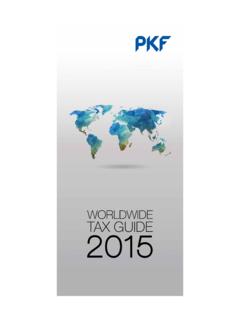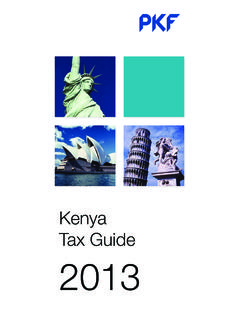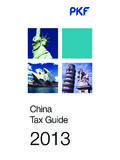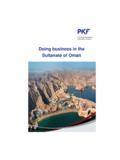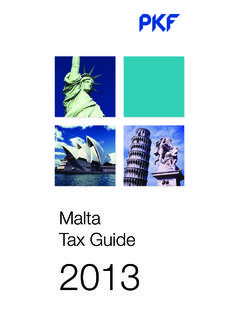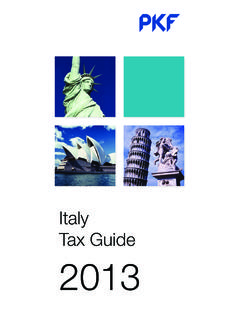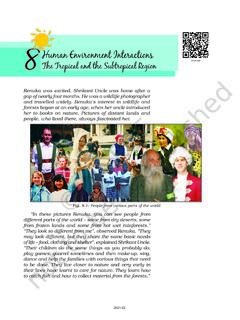Transcription of IFRS 12 Disclosure of Interest in Other Entities - PKF
1 S U M M A R Y ifrs 12 Disclosure of Interest in Other Entities 1 Overview ifrs 12 requires all disclosures that were previously required by IAS 27 Consolidated Financial Statements, IAS 31 Interest in Joint Ventures and IAS 28 Investment in Associates. In addition, ifrs 12 requires a number of new disclosures and one of the most significant of these is the judgements made by an entity to determine whether it controls another entity. These changes were introduced by the IASB partly in response to the financial crisis and are intended to improve transparency as to the judgements made in deciding whether or not to consolidate and the financial impact if management reached a different conclusion. Objective The objective of ifrs 12 as set out in the standard is to require an entity to disclose information that enables users of its financial statements to evaluate: the nature of, and risks associated with, its interests in Other Entities ; and the effects of those interests on its financial position, financial performance and cash flows.
2 To meet this objective, an entity shall disclose: The significant judgements and assumptions it has made in determining: - The nature of its Interest in another entity or arrangement; - The type of joint arrangement in which it has an Interest ; - That it meets the definition of an investment entity if applicable; and Information about its interests in: - Subsidiaries; - Joint arrangements and associates; and - Structured Entities that are not controlled by the entity. Aggregation ifrs 12 emphasises that it s necessary for financial statement preparers to strike a balance between burdening financial statements with excessive detail that may not assist users of financial statements and obscuring information as a result of too much aggregation. An entity shall present information separately for the following interests ( aggregation is not allowed): Subsidiaries Joint ventures Joint operations Associates Unconsolidated structured Entities .
3 An entity shall consider the following when determining whether to aggregate information: Quantitative and qualitative information about the risk and return characteristics of each entity considered for possible aggregation; and The significance of each entity to the reporting entity. ifrs 12 Disclosure of Interest in Other Entities 2 Examples of aggregation levels that may be appropriate are: Nature of activities. Industry classification. Geography. Scope ifrs 12 shall be applied by an entity that has an Interest in ANY of the following: Subsidiaries Joint arrangements (joint operations or joint ventures) Associates Unconsolidated structured Entities . ifrs 12 does not apply to: Post-employment benefit plans or Other long-term employee benefit plans to which IAS 19 Employee Benefits applies.
4 An entity s separate financial statements to which IAS 27 Separate Financial Statements applies. An Interest held by an entity that participates in, but does not have joint control or significant influence over a joint arrangement. An Interest accounted for in accordance with ifrs 9 Financial Instruments, except for: - Interest in an associate or joint venture measured at fair value through profit or loss in accordance with IAS 28 Investments in Associates and Joint Ventures; or - Interest in an unconsolidated structured entity. ifrs 12 - effective date ifrs 12 shall be applied for annual periods beginning on or after 1 January 2013. An entity shall apply those amendments made to ifrs 12 with regards to Investment Entities for annual periods beginning on or after 1 January 2014.
5 Early application is permitted. Defined terms Structured entity An entity that has been designed so that voting or similar rights are not the dominant factor in deciding who controls the entity, such as when any voting rights relate to administrative tasks only and the relevant activities are directed by means of contractual arrangements. Income from structured entity Income from a structured entity includes, but is not limited to, recurring and non-recurring fees, Interest , dividends, gains or losses on the re-measurement or derecognition of interests in structured Entities and gains or losses from the transfer of assets and liabilities to the structured entity. Significant judgements and assumptions Information about significant judgements and assumptions (including changes to those judgements and assumptions) made by an entity in determining the following should be disclosed: That it has control of another entity; That it has joint control of an arrangement or significant influence over another entity; and The type of joint arrangement (joint operation or joint venture) when it has been structured through a separate vehicle.
6 Examples of situations that require Disclosure The entity: Does not control another entity even though it holds more than half of the voting rights. Controls another entity even though it holds less than half of the voting rights. Is a principal or an agent. Does not have a significant influence even though it holds 20% or more of the voting rights. ifrs 12 Disclosure of Interest in Other Entities 3 Has significant influence even though it holds less than 20% of the voting rights. Disclosure information required under ifrs 12 Interest in subsidiaries Objective An entity is required to disclose information that enables users of its consolidated financial statements to Understand: The composition of the group; and The Interest that non-controlling interests have in the group s activities and cash flows; and Evaluate The nature and extent of significant restrictions on its ability to access or use assets, and settle liabilities, of the group; The nature of, and changes in, the risks associated with its interests in consolidated structured Entities ; The consequences of changes in its ownership Interest in a subsidiary that do not result in a loss of control.
7 And The consequences of losing control of a subsidiary during the reporting period. Disclosure Non-controlling interests in group activities and cash flows For each of its subsidiaries that have a non-controlling Interest that is material and shows Interest in the group s activities and cash flows, the reporting entity shall disclose the following The name of the subsidiary The principal place of business and country of incorporation of the subsidiary The proportion of ownership interests held by non-controlling interests The proportion of voting rights held by non-controlling interests, if different from the proportion of ownership interests held The profit or loss allocated to non-controlling interests of the subsidiary during the reporting period Accumulated non-controlling interests of the subsidiary at the end of the reporting period Summarised financial information about the subsidiary Refer to illustrative Disclosure example that follows Nature of risks in consolidated structured Entities When a parent, subsidiary relationship exists, the following is required to be disclosed in the group financial statements Terms of any contractual arrangements that could require the parent or its subsidiaries to provide financial support to a consolidated structured entity.
8 Including events or circumstances that could expose the reporting entity to a loss If during the reporting period, financial or Other support is provided to a consolidated structured entity, without having a contractual obligation to do so - The type and amount of support provided - The reasons for providing the support If financial or Other support has been provided to a previously unconsolidated structured entity that resulted in control, an explanation of the relevant factors in reaching that decision Any current intentions to provide financial or Other support to a consolidated structured entity, including intentions to assist the structured entity in obtaining financial support Illustrative Disclosure example - significant judgements and assumptions Himalayas Group Limited Notes to the consolidated financial statements for the year ended 31 December 2013 6.
9 Significant judgements and assumptions Control over Alps Limited It was concluded that Alps Limited is a subsidiary of Himalayas Limited even though Himalayas Limited only has 48% voting rights and ownership interests in Alps Limited. The remaining 52% is widely held by thousands of unrelated shareholders. An assessment of control was performed by Himalayas Limited based on whether Himalayas Limited has the practical ability to direct the relevant activities unilaterally. In making their judgement, the relative size and dispersion of Other vote holders, potential voting rights held by them or others, rights from Other contractual arrangements were considered. After the assessment, Himalayas Limited concluded that they had a dominant voting Interest to direct the relevant activities of Alps Limited and it would take a number of vote holders to outvote Himalayas Limited therefore Himalayas Limited has control over Alps Limited.
10 ifrs 12 Disclosure of Interest in Other Entities 4 Nature and extent of significant restrictions When a parent, subsidiary relationship exists, the following is required to be disclosed in the group financial statements Significant restrictions on its ability to access or use assets and settle the liabilities of the group The nature and extent to which protective rights of non-controlling interests can significantly restrict the entity s ability to access or use the assets and settle the liabilities of the group The carrying amounts in the consolidated financial statements of the assets and liabilities to which those restrictions apply Consequences of changes in a parent s ownership Interest in a subsidiary That does not result in a loss of control The entity shall present a schedule that shows the effects on the equity attributable to owners of the parent of any changes in its

